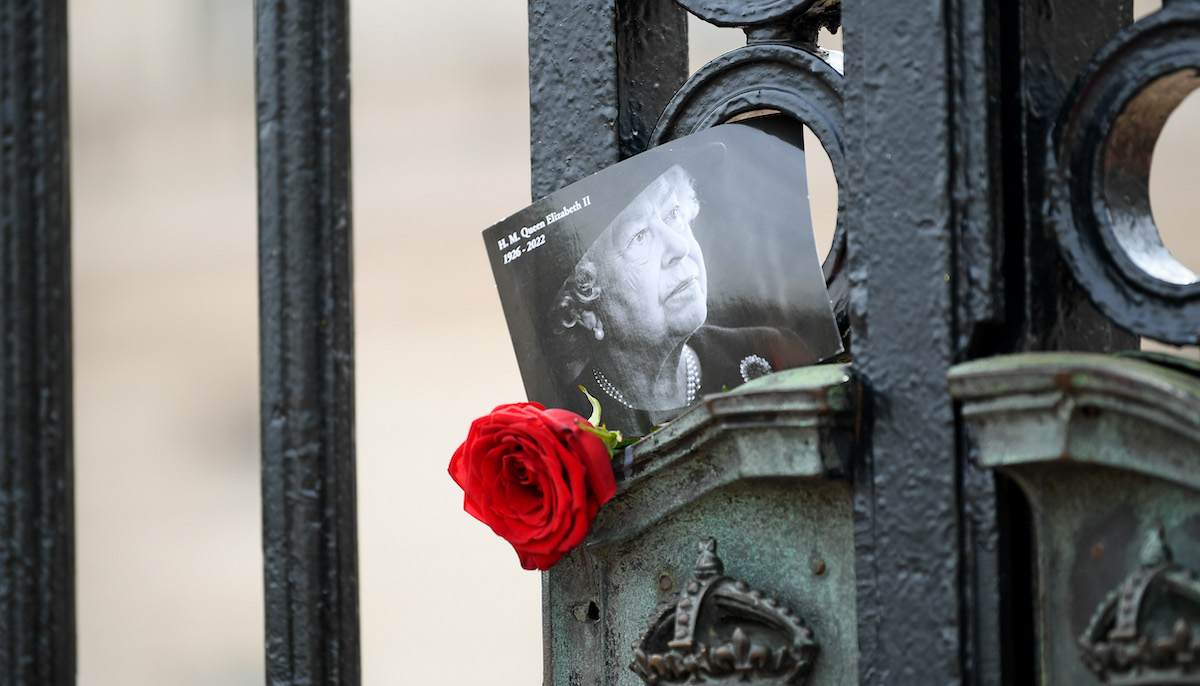It's the first anniversary of Queen Elizabeth II's death. Her cause of death was attributed to old age, according to a death certificate made public a few weeks after her passing.
Her death certificate state that she died on Sept. 8, 2022, at 3:10 p.m. local time (10:10 a.m. Eastern time) in Balmoral Castle in Scotland. The cause was "old age." "Her Majesty The Queen" was the response int he occupation field for Britain's longest-reigning monarch, whose name was marked as Elizabeth Alexandra Mary Windsor.
The queen's death was announced shortly after she was placed under "medical supervision" because her doctors were "concerned for Her Majesty's health," according to an announcement from Buckingham Palace at the time. Senior royals flocked to her side, and her death was announced shortly after 1:30 p.m. EST.
Following one of her last appearances, when she appointed the new British prime minister, Liz Truss, concerns swirled about the queen's health. She wasn't able to travel to London for the occasion, a break from tradition, and in photos of the event, some of the last of the queen, she used her cane indoors, and her hand appeared quite purple.
Feeling out of the loop? We'll catch you up on the Chicago news you need to know. Sign up for the weekly Chicago Catch-Up newsletter here.
Details are light on how the queen died, but here's what we know about her health leading up to her death.
How did Queen Elizabeth die?
As far as how Queen Elizabeth died, the palace did not provide many details, saying only that she died "peacefully" at Balmoral Castle in Scotland, where she has traditionally spent her late summer holiday.
What does it mean to die of old age?
The queen's death certificate stated that she died of "old age," a term that generally refers to "dying of natural causes related to aging," according to Cake, a popular end-of-life planning tool. Usually, there isn't one major factor that contributed to the death. The person may have had underlying conditions or developed a condition that a younger person would've survived, such as pneumonia.
Leading up to her death, the queen's health had been under close scrutiny, especially as the monarch experienced a bout of COVID-19 and dealt with "episodic mobility issues," as the palace has called it.
More: Queen Elizabeth II
Queen Elizabeth was hospitalized in Oct. 2021 and told to make 'lifestyle changes'
Late in October 2021, the queen canceled a scheduled trip to Northern Ireland and was briefly hospitalized. At the time, few details were announced, but Buckingham Palace said the monarch had "reluctantly accepted" medical advice recommending she take some time off. This was her first known health issue since 2017.
Later that month, Queen Elizabeth was advised by doctors not to attend a climate summit in Scotland due to health concerns. Doctors then recommended she rest for two more weeks and only undertake minor responsibilities.
“The doctors have advised that Her Majesty can continue to undertake light, desk-based duties during this time, including some virtual Audiences, but not to undertake any official visits,” said a statement from Buckingham Palace.
During that time, doctors advised the queen that she should cut out her evening nightcap, a signature cocktail that she has consumed for decades. The monarch's schedule was also lightened.
A back sprain in November 2021 caused her to miss a major event
Shortly after her October cancellation, Queen Elizabeth missed a Remembrance Sunday event in London because of a back sprain.
She was “deeply disappointed to miss the engagement which she regards as one of the most significant engagements of the year,” a source told TODAY at the time. A few days later, Charles, Prince of Wales, told Sky News that his mother was doing "all right."
“Once you get to 95, it’s not quite as easy as it used to be,” he said, joking, “It’s bad enough at 73.”
The queen contracted COVID-19 in February 2022
Queen Elizabeth was diagnosed with the coronavirus in late February. She experienced "mild cold-like symptoms" and continued light duties at Windsor Castle during this time, Buckingham Palace said.
At the time, she did cancel some virtual meetings before resuming online audiences in early March 2022. She later missed a Commonwealth Day service in mid-March.
Queen Elizabeth was rarely seen in the spring of 2022
Between late March and mid-May 2022, the queen did not attend any public events. In April, she missed Easter celebrations, and in May, she did not attend the ceremonial opening of Parliament due to "mobility issues."
That absence was just the third time in 70 years that the monarch did not attend the opening of Parliament.
Queen Elizabeth returned to the public eye on May 13, when she attended the Royal Windsor Horse Show. The event is beloved by the queen and features several of her own horses.
The queen missed some Platinum Jubilee celebrations in June
The Platinum Jubilee was full of events celebrating Queen Elizabeth's 70 years on the throne, but the monarch was not present at all of those activities.
The queen attended the Trooping the Color parade, but because of "some discomfort," she missed a thanksgiving service at St. Paul’s Cathedral on Friday and did not attended a Derby horse race at Epsom Downs that Saturday. She also missed the Platinum Party on Saturday.
Queen Elizabeth did make a surprise appearance on the balcony of Buckingham Palace on Sunday. Other senior royals also stood by her side.
The queen missed a 'beloved' event near Balmoral Castle
In September 2022, the queen missed the “beloved” Braemar Highland Games, held in Scotland near Balmoral Castle, because of mobility issues.
Queen Elizabeth broke with tradition to appoint a new prime minister in Scotland
Typically, the monarch appoints a new prime minister in London. However, when it came time for Boris Johnson to be replaced by Liz Truss on Sept. 6, the two politicians traveled to Scotland so the event could be held at Balmoral Castle.
This was the first time in the queen's 70-year reign that the prime minister was appointed in Scotland. Truss is the 15th prime minister of Queen Elizabeth’s reign.
“It’s a very significant change because if the queen was able to travel, she would,” Craig Prescott, an expert in constitutional law and politics at Bangor University in Wales, told TODAY. “It’s an indication of her mobility problems, and another step on that journey we’re going on, with the queen doing less and less.”
The next day, Sept. 7, the queen cancelled a virtual meeting with her privy council, a formal body of advisors including Truss, after doctors advised her to rest.
Queen Elizabeth II died in September 2022
In a statement on Sept. 8, Buckingham Palace said: "The Queen died peacefully at Balmoral this afternoon. The King and The Queen Consort will remain at Balmoral this evening and will return to London tomorrow."
This story first appeared on TODAY.com. More from TODAY:



